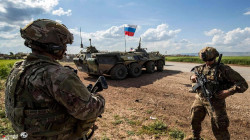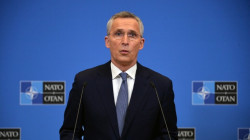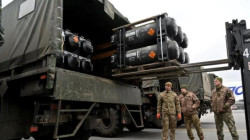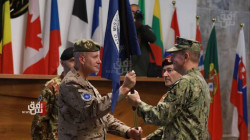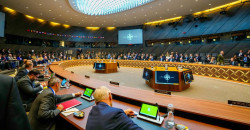Report: Misaligned in Mesopotamia: Conflicting ambitions in Nato Mission Iraq

Shafaq News / The rapid collapse of the Afghan government has prompted an agonized and wide-ranging debate across the NATO alliance about what went wrong. Among other things, it is now painfully clear that there was a longstanding mismatch between the goals of the NATO mission and the realities facing the Afghan government, particularly its security forces.
Over the past two years, I saw evidence of a similar mismatch while serving in the NATO mission to Iraq. Among other roles, I led a number of high-level NATO advisers working in the Iraqi Ministry of Defense. There, I had a chance to look into the engine room and observe some of the contradictions, complications, and shortcomings of NATO’s approach.
My purpose here is not to be unduly pessimistic or to draw exaggerated parallels with Afghanistan. NATO is doing important work in Iraq, and the Iraqi government is grateful for its presence. But to succeed, NATO’s leadership must align its interests with those of the Iraqis they are there to help. First, this means better coordinating NATO’s policies and messaging with the Iraqi government. And second, it means understanding the logic of the Iraqi security establishment rather than simply trying to recreate it in the image of a NATO military.
Background
As Iraq has been through almost 20 years of internal conflict, improving the skills and success rate of the Iraqi military is not a simple task. It requires patience. Moreover, the NATO mission in Iraq is an advisory mission there at the invitation of the Iraqi government. It is a non-combat mission and has only very limited leverage with the Iraqi government. There is no real carrot or stick if the Iraqis do not agree on a priority.
NATO’s current engagement in Iraq began in 2015 with a demand-driven Defense Capacity Building package. This was tailored to provide advising, assistance, and training within the Iraqi defense sector. A trust fund was also established with money to support different aspects of capacity building. In 2018 a formal mission was established: NATO Mission Iraq. This involved military trainers providing tactical-level training at different Iraqi branch schools and civilian and military experts providing strategic level advice in the Iraqi Ministry of Defense. Canada led the NATO mission from 2018 until November 2020.
When Denmark took over the management of the mission in November 2020, it was in a somewhat dilapidated state. Due to the security situation and COVID-19, virtually all of the mission’s activities had been shut down between January and August 2020. Over the late summer and autumn, the mission staff and the Canadian leadership worked hard to get as much of the mission re-established as possible before Denmark took command. On Oct. 31, the mission declared “full operational capability.”
Mounting Mismatch
It soon became clear, however, that the mission was not fully ready. Most significantly, the tactical-level advisory plan that had been written to guide the activities of the mission on the ground in Baghdad did not have the necessary resources or, crucially, the support of the Iraqi Ministry of Defense. Basically, the realities on the ground were not in sync with the strategic communications from NATO and the ambitions at headquarters.
This misalignment only deepened in February 2021 when NATO Secretary General Jens Stoltenberg announced the growth of the NATO mission from 500 to 4,000 personnel. He also announced that NATO would expand its advising activities to include additional Iraqi institutions like the Ministry of Interior, the Ministry of Peshmerga, and the Counter Terrorism Service.
Stoltenberg’s announcement was intended to show that NATO was strongly committed to the fight against terrorism and remained an actor in the international security arena. In Baghdad, however, many of us working in the NATO mission were caught by surprise. NATO’s messaging had obviously not been coordinated with the actual stakeholders in Iraq and indeed was not even targeted at them. I was working at the time as director of the Ministerial Advisory Division and head of all NATO advisors working in the Iraqi Ministry of Defense. I saw firsthand the frustration this caused.
Looking down the corridor of the Advisory Division in Union III at the mission headquarters in Baghdad, I could see a lot of empty chairs. I was simply short of resources, and I knew from a recent high-level meeting in the Iraqi Ministry of Defense that there was no particular appetite for the mission to expand to include additional institutions beyond the Ministry of Defense.
The whole “numbers game” was also an extremely sensitive point for the Iraqi government. From an Iraqi point of view, the 3,500-person increase caught them by surprise. They knew from intensive dialogue between the NATO mission and the Iraqi government that the mission was set to expand. However, they knew nothing about the number. The political situation in the country was very fragile, and no one wanted to be publicly on the hook for letting such a large number of foreign troops enter the country.
Best–Laid Plans
When the mission expansion was announced, the NATO headquarters in Mons, Belgium and in Naples, Italy were producing revised operation plans. Also, two years after the mission began, we were in urgent need of a new tactical-level advisory plan because the current one was not fully supported by the Iraqi Ministry of Defense.
Consider several examples. NATO plans called for the mission to advise that the Iraqis merge their two military intelligence services into one and their five military commands into three. After approximately a month of interaction with the Iraqis in late 2020, it turned out that the Ministry of Defense did not want to implement these measures. The plan lacked an understanding of the logic of the Iraqi security establishment and seemed to be an expression of the wishes of the West rather than of what the Iraqis actually wanted or needed.
As a result, the merging of the two military intelligence services was a non-starter from the beginning. One of the services, called M2, is a tactical-level service that provides intelligence at the unit level. M2 reports to the chief of defense. It is an old service and it primarily works through human intelligence. The other service, the Directorate General for Intelligence and Security, is a newly-established operational and strategic service that reports to the minister of defense and has more diverse intelligence assets than M2. When engaging with the primary Iraqi military decision-makers, it was obvious that there was no appetite for merging the two services. It was politically impossible under the current circumstances. The same was the case with the merging of Iraq’s five service commands into three. Army aviation was supposed to be subject to the ground forces and air defense subject to the air force. However, that was counter to Iraqi ambitions. In short, important elements of our plans reflected NATO’s way of doing things, not the Iraqis’.
These examples illustrate how hard and time-consuming it is to develop and implement a demand-driven plan in a complex, politically tense security environment. There was a logic to Iraqi power relations and its system of multiple overt and covert agendas. Successfully working within this required numerous engagements at many levels in order to build a feeling of local ownership and create sustainable plans for development.
One could say that external advisers may know better than Iraqis what advice to give. But when the mission is “demand-driven,” it can be difficult if not impossible to create ownership and engagement on advice that is not in demand. Often, the NATO headquarters in Naples was convinced that we simply needed to be more forceful. “Have you slammed your hand on the table?” one NATO general asked, apparently forgetting that NATO is not in Iraq as an occupying power.
The fact is sometimes we did slam the table. Sometimes it helped. But when the subject wasn’t something the Iraqis were interested in, it had no effect. Slamming the table has to be done intelligently, alongside explaining the benefits of improvements and reform. When the Iraqis disagreed on an overall objective, it could take months to plan a meeting. When there was agreement and ownership, the meeting could be scheduled within a few days.
How Can NATO Do Better?
Rethinking NATO’s approach can help its mission succeed, thereby enhancing the security of Iraq and the alliance as well.
First, NATO decision-makers need to align their ambitions with those of Iraqi decision-makers. It is obvious when working in the engine room of the mission that NATO does not fully know what achievements to work towards and why NATO is in fact present in Iraq. If NATO is there to support the fight against terrorism in a demand-driven mission, then NATO needs to actually listen to the Iraqis and reflect their messaging. Trying to simultaneously speak to a Western audience focused on the survival of NATO and an Iraqi one concerned about the presence of foreign troops in the country will hamper the mission’s prospects.
Second, NATO planners should lower their criteria for success. Today, the mission in Iraq is subject to completely unrealistic demands from NATO headquarters. Institutional advising at the strategic level requires great patience. Spending time on quantitative measurements — for example, tallying the percentage of the Iraqi security forces that have received training in human rights — is a waste of time. All the more so for a mission that does not provide human rights training or even know the total number of Iraqi security forces. In short, the success of a mission focused on developing long-term defense planning, readiness systems, or logistics capabilities cannot be measured in quantitative terms alone.
Despite the contradictions, complications, and shortcomings of NATO’s approach, the mission has made real progress since October 2020 in developing a new advisory plan in close cooperation with the Iraqis. During this time, advisors also built strong relations with their main interlocutors and engaged with Iraqis at all levels within the Ministry of Defense.
The result of these efforts was that by February 2021 the mission had a new advisory concept that the Iraqis applauded and a new advisory plan that the Iraqis agreed with. In fact, it was the first time that they themselves had seen the mission complete a detailed plan for the work they wanted and had been allowed the chance to give feedback. NATO’s dreams of merging their two military intelligence services into one and their five military commands into three were abandoned. As a result, more emphasis could be given to institutional development. And this meant the things the Iraqi Ministry of Defense was waiting for, such as defense planning programs, human resource advising, and doctrine development.
This progress shows what patience, understanding, and greater alignment can achieve. It should be a model for success — in Iraq and also for other missions to come.
Source: War On Rocks
